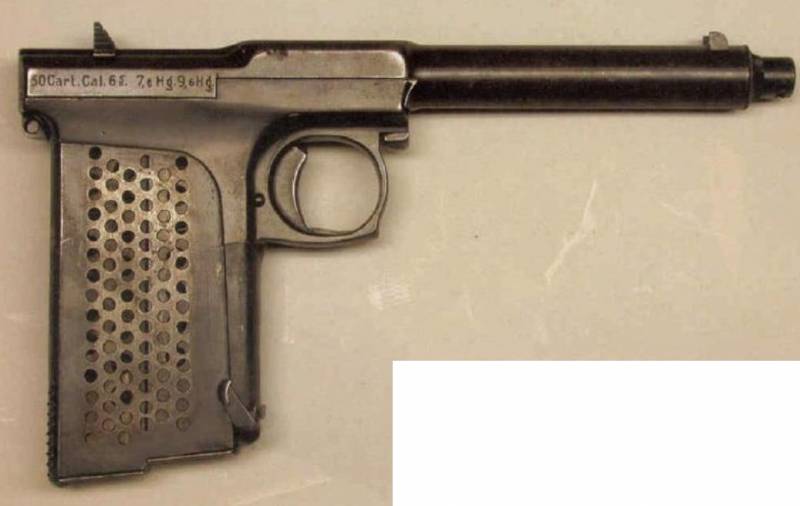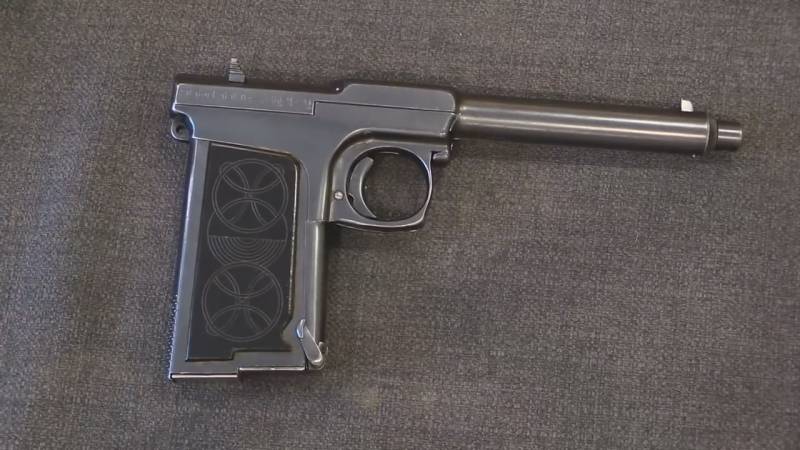50 ammo in the grip. H. Sunngord self-loading pistol
15 September 201815
A characteristic problem of modern pistols is limited ammunition, due to the permissible size of the store. A detachable magazine in the handle can accommodate no more than a couple of dozen cartridges, and a further increase in its capacity is impossible or associated with difficulties. At the beginning of the last century, the Norwegian designer Harald Sunngord proposed an original pistol complex, which included the actual gun and a special cartridge for it. Due to special ideas and solutions in weapons managed to place two stores at once with 25 rounds each.
Stores of self-loading pistols of the beginning of the 20th century did not differ in large capacity and basically contained no more than a dozen cartridges. However, in combat conditions, such ammunition could be insufficient, and the replacement of the store took time and led to risks. An interesting solution to this problem was proposed by the Norwegian engineer H. Sunngord, but for this he had to create from scratch not only a gun and a magazine for him, but also a specialized cartridge.
Repair & diagnostics tester for Antminer S19XPhydro
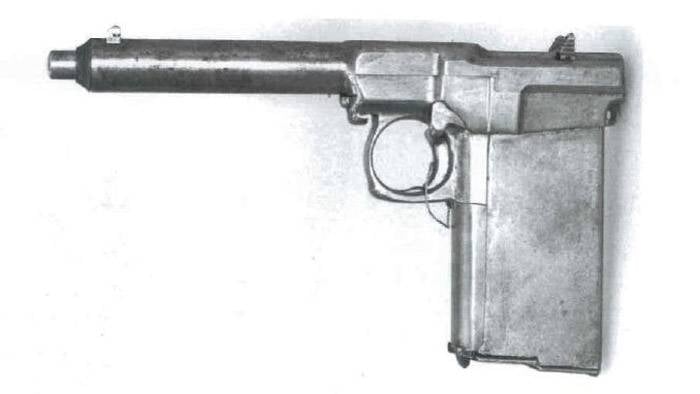
One of the earliest prototypes of H. Sunngord pistol. It differs from later products in the absence of a slide delay.
According to known data, a new weapons project was developed by the 1909 year, and then its author produced several prototypes and a batch of new cartridges. In the next 1910 year, H. Sunngord took up the defense of his rights to invention and received the necessary patents from the departments of different countries. In particular, a new weapon design was registered in the United States.
Like other models of small arms, the new pistol with increased ammunition was named by the name of the designer - Sunngård pistol. Soon after its appearance, the project was developed: a new version appeared under a different cartridge. In some foreign sources, two variants of a pistol for different ammunition are referred to as Model 1909 and Model 1910. However, as far as we know, initially such names were not used.
The project of H. Sunngord was based on several basic ideas. First, the designer decided to use the most advantageous combination of a large and capacious store with a compact but powerful enough cartridge. He also proposed to place a spare store not in a holster or pouch, but directly in the weapon. Moreover, the second store had to be close to the one used, and its transfer to the working position could take a minimum of time. As a result, the shooter could have the maximum possible ammunition, ready for use, and the pause between the “change” of the store was minimal.
Especially for his gun, H. Sunngord created a special cartridge. A product of type 6,5x19 mm had a total length of 23 mm. A bullet weighing 28,5 grana (1,85 g) could accelerate to 600 m / s. Later, probably, according to the test results of the first pistol, the designer created the second special cartridge - 8х19 mm. His bullet weighed 29 Gran (1,88 g) and developed speed at the level of the previous sample. At the expense of the new patron, it was planned to get some increase in combat qualities, but they had to pay for them by reducing their ammunition.

Same product, top view
The gun, designed to use the new cartridge, differed simplicity of design. H. Sunngord used proven solutions in the form of automation with a free gate and without locking the barrel. At the same time, the weapon had to have a distinctive appearance, including due to the presence of a mine just below two stores. A thin and light shutter casing was developed, and the frame was distinguished by a large and wide handle. Some interesting ideas have been implemented in the trigger mechanism.
The layout of the Sunngård pistol was traditional. All main parts were placed on a relatively compact frame. Its upper part was a guide for the movable casing and occupied about half the total length of the gun. Under the guide, a trigger guard was placed at the front, followed by a special handle. The latter had a rectangular shape and was placed almost vertically. The lower cut of the handle is made in the form of a broken line. The walls of the handle had perforations; on top of them it was possible to install small thickness plates.
The casing of the bolt of the construction of X. Sunngord received a cylindrical front part with a nut-cap through which the muzzle end passed. The cylinder occupied about half of its length. Behind the cylinder on the casing there was a thickening with an almost rectangular section, in the cavity of which the cartridge was to be moved. At the rear of the bulge there was a shutter without locking means. Details of the firing mechanism were placed under the rear part of the casing, which had a reduced cross section.
The first version of the gun was equipped with a rifled barrel caliber 6,5 mm and a length of 158 mm. The barrel was rigidly fixed on the frame and should not have moved when firing. When assembling, a return spring was put on the barrel, after which a bolt casing was installed on top of it. One end of the spring in contact with the front wall of the casing, the other - with an emphasis on the trunk and frame.
The pistol received a trigger type trigger. At the back of the casing was placed a drummer with a mainspring, capable of moving back and forth. The drummer was U-shaped: one of its elements was on the axis of the bolt and had a striker head, the other was placed at the left side, it was intended to interact with the sear. War spring was in the housing at the rear. In the cocked position, the U-shaped drummer was braked by the sear, placed behind the trigger guard. When you click on the hook, it rose and pushed the corresponding part of the drummer.

bottom view
After modernization, the product was equipped with a slide delay, which allowed the casing to be stopped in the rear position. The corresponding lever was on the left, above the trigger. Due to the special form of the internal axis, the delay was also responsible for blocking the striker until the moment the shutter was fully rolled and prevented a premature shot. There was also a non-automatic fuse controlled by a lever on the left side of the handle.
The greatest interest in the project of H. Sunngord was the ammunition system, for which the inventor, in fact, created the whole complex. The cartridges should have been placed in detachable box stores. The first shop appeared chambered for 6,5х19 mm. Inside it, ammunition was placed in two vertical rows of 12 pieces in each. Another cartridge was in the lips of the store and was ready to be sent to the chamber. The store had a traditional spring feeder.
With one gun it was proposed to use three full-time stores. Two had a box-shaped body with a smooth back wall, while the third had a hook with a wire hook. Shops should be used in a specific order, and the crocheted item was second in line.
Two stores could enter the large and wide shaft of the pistol grip. Above between the shops there was an emphasis, holding the front in the working position. Below it was fixed by a latch with a lever. Directly behind the first store was the second. He relied on the upper support and on the back wall of the shaft. Bottom supported him hard stop. The wire hook hooked onto a special shaft at the top of the shaft. The bottom edge of the handle had a broken shape, which is why the back shop was just below the front and did not interfere with the operation of automation. The third store should be kept in a holster.
The designer equipped his weapon with the simplest sights. In front of the casing was a front sight with a small lateral protection. Behind the casing was located the rear sight, also covered from the side.
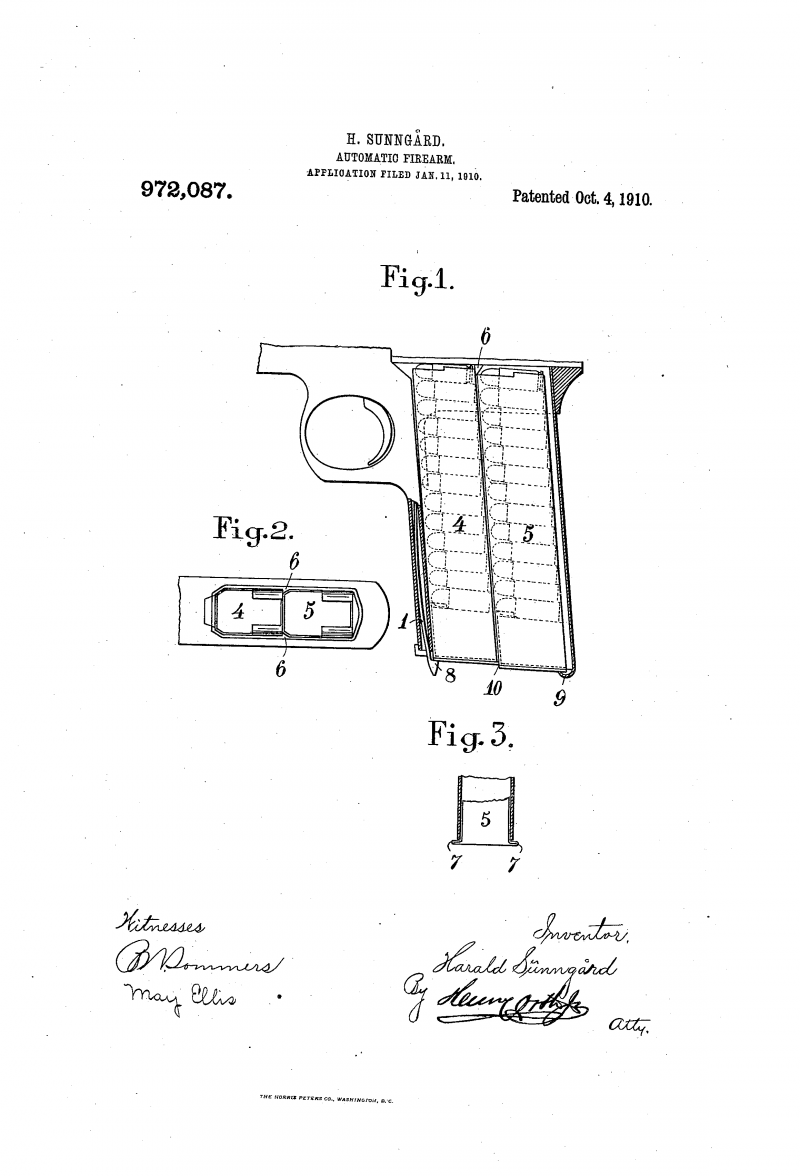
Drawing from the patent showing the design of the handle and shops
The Sunngård pistol product had a total length of 203 mm with a height of 135 mm. The own weight of the weapon was 760. The magazine with 25 cartridges 6,5x19 mm weighed about 100 g. Thus, a pistol with a full ammunition load pulled almost per kilogram. The possibility of obtaining a relatively high technical rate of fire was announced. The estimated effective range did not exceed several tens of meters.
A special holster was attached to the pistol. Inside it was provided for a separate pocket for carrying one of the stores (“third”). Thus, the total ammunition pistol could consist of 75 cartridges, of which 50 were in the weapon.
The operation of the pistol by H. Sunngord was quite interesting and unusual. Having equipped two shops, it was necessary to place them in a handle. The first was inserted “second”, equipped with a hook. It was placed in the back of the shaft, its hook clung to the upper axis, and the bottom rested against the lower stop of the handle. Only after that, shop #1, which became “active”, should have been installed - he was to submit cartridges to the weapon. It was located just above the spare and was fixed with a spring latch.
Having made 25 shots and devastated the first store, it was necessary to perform a simple “recharge”. For this, the shooter had to squeeze the front store latch and remove it. Then the rear magazine was manually moved forward, slightly raised and fixed in the working position. The wire hook facilitated this process by controlling the path of the store. Then it was possible to cock the weapon (or remove the bolt from the delay) and continue firing.
After the next 25 shots, the “second” magazine should be returned to its original position. In its place it was possible to place the third store, while remaining in a holster.
Thus, the Sunngård pistol pistol of the first version could make three series of 25 shots with a minimum break between them. In one medium-sized pistol managed to place a record ammunition. Moreover, in contrast to a number of later pistols and shops, this time it was about the standard equipment of weapons.
The first version of the gun H. Sunngord appeared in 1909 year and then passed the necessary checks. Apparently, the result did not fully suit the inventor, and therefore the project was continued. The 6,5x19 mm cartridge could hardly show high performance and fighting qualities, due to which he needed to be replaced. Soon, the designer offered a new ammunition.
The cartridge of the new type was developed taking into account the peculiarities of the existing and prospective weapons. The liner extension was not possible due to ergonomic considerations, and therefore the characteristics were increased by increasing the caliber. At the same time, the volume of the liner and the allowable weight of the powder increased. However, the mass and speed of the new 8-mm bullets differed little from the parameters of the existing one.
To use the new cartridge 8х19 mm pistol H. Sunngorda has undergone significant changes. A new trunk of a larger caliber with a length of only 135 mm was used. The shape of individual parts and assemblies has changed, although the overall exterior of the product has generally remained. Finally, decreased ammunition. Each of the stores contained only 18 cartridges - in the amount of 36. The dimensions of the weapon almost did not change, and its own mass grew by only 40.
Approximately in 1910, new prototypes of the Sunngård pistol were manufactured for a larger caliber cartridge. They had to pass tests, during which they hardly managed to show a noticeable increase in technical characteristics and combat qualities. However, this time the gunsmith did not begin to create a new cartridge and alter the weapon under it.
According to various sources, at the turn of the decades, Harald Sunngord tried to offer his weapons to several European armies, primarily the Norwegian one. It is easy to see that potential customers showed no interest in this development. No contract for the supply has not appeared.
In 1914, the Norwegian army held a competition for the purchase of modern pistols. Several foreign companies took part in it. The domestic industry was represented by the product Sunngård pistol. Several types of weapons passed comparative tests, and the military made their decision. The most successful was considered an American pistol M1911 designed by John Moses Browning. The army adopted it under the designation 11,25 mm Automatisk pistol M / 1914. Soon one of the Norwegian factories launched licensed production.
Taking into account such results of the competition, it is possible to imagine what exactly the gun of H. Sunngord did not suit the Norwegian army. The American M1911 seriously surpassed the Norwegian Sunngård pistol in firepower. The stopping and killing effect of the .45 ACP cartridge was much higher than that of the small-sized 6,5x19 mm. Also, a foreign gun favorably distinguished by a greater range of effective fire. At the same time, the M1911 had an “ordinary” handle and was much easier to handle.
The only advantage of domestic development was a uniquely large ammunition. However, a potential customer might have doubted the expediency of this. The self-loading pistol was considered as a weapon of self-defense officer, and in this role he did not need ammunition in the form of several dozen cartridges, especially low-power ones. In addition, a pair of stores increased the size of the handle and affected the convenience.
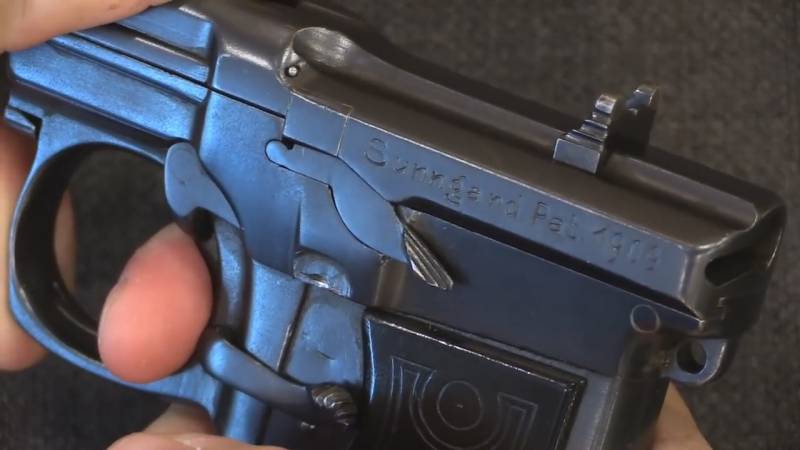
The left side of the gun Sunngord with controls
According to the results of the comparison, the Norwegian military chose a model that was not distinguished by the courage of the design. The product, actually built around one interesting, but not quite unambiguous idea, did not interest them. It is known that in the same period H. Sunngord tried to offer his gun to foreign armies, but they also did not want to purchase such weapons.
According to some reports, only a few Sunngård pistol pistols have survived. One of them has a caliber 6,5 mm, the second - 8 mm. According to some versions, these were the only prototypes made, and other pistols were initially absent. Sunngord’s 6,5-mm pistol is now stored in a museum in Norway. The second sample got to the Wehrtechnische Studiensammlung Museum in Koblenz, Germany in one way or another.
The project of Harald Sunngord pursued a very specific goal - the maximum possible increase in ready-to-use ammunition. To solve this problem, the gunsmith had to create a special cartridge and use the unusual design of the pistol itself. The main objective of the project was completed, but too expensive. The pistol showed insufficient firing characteristics, and therefore could not interest the military. Not the most successful combination of ammunition and firepower did not allow the gun to go into service, but it provided him a place in the list of interesting, albeit useless, developments.
